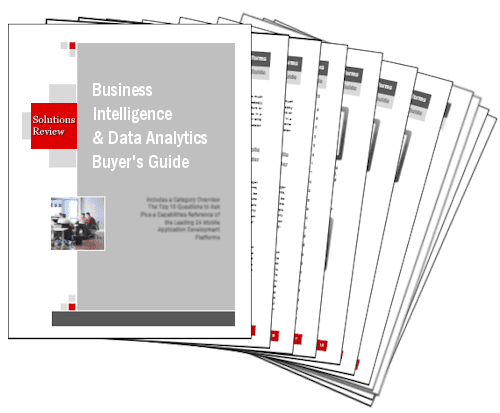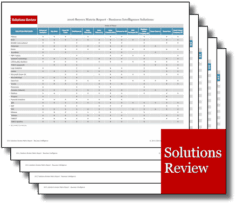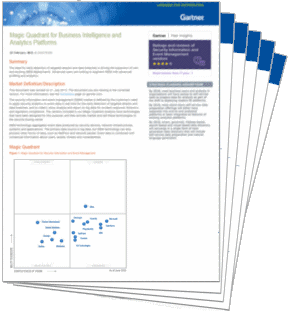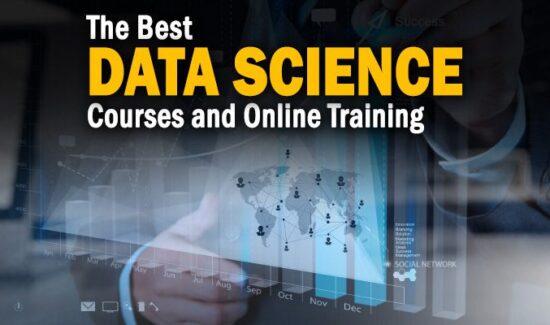Better Than Futurama: How M2M and Big Data Are Changing How We Work and Live

 Today we have a nice piece of contributed content on the hot topic of Machine 2 Machine (M2M) from Sam Ganga, an Executive Vice President at DMI – a leading provider of mobile enterprise solutions.
Today we have a nice piece of contributed content on the hot topic of Machine 2 Machine (M2M) from Sam Ganga, an Executive Vice President at DMI – a leading provider of mobile enterprise solutions.
The 1964 World’s Fair in New York was dedicated to “Man’s Achievement on a Shrinking Globe in an Expanding Universe.” The General Motors pavilion depicted the world of tomorrow with its wildly popular Futurama ride. Audience members rode in moving chairs past exhibits depicting future wonders such as a moon colony, large-scale underwater mineral mining and laser-logging equatorial jungles to build highways that would bring “the goods and materials of progress and prosperity” to emerging economies.
Fast-forward half a century, and we see that while Futurama’s predictions of vast highways and self-paced cars come close to the mark, most of its other lofty ideas have yet to be realized. However, other advances that promise even greater benefits have emerged, in the form of Machine to Machine (M2M) communication and Big Data Analytics. Organizations, entrepreneurs and governments are already leveraging these advances to save money, increase productivity and create products and services that serve both business and humanity.
+ Check Out a Free 2015 Business Intelligence Tools Buyers Guide
M2M: Talking Machines
Networked devices need to exchange information (communicate) and to perform actions without (or with minimal) human intervention. M2M describes technologies and systems that enable this. Gathering sensor data from devices, analyzing it and using it to exercise more intelligent control can drive better outcomes. Some day-to-day examples include:
- Sensors in smart buildings gather environmental data that can be analyzed to save energy and improve safety.
- Onboard emergency systems can alert paramedics and police when accidents occur, even when the humans involved aren’t able to help themselves.
- Utility companies use smart meters and predictive analytics to predict demand patterns, automatically adjust to meet peak demand and avoid over-production when demand is low.
- Shifts in traffic patterns can be predicted by analyzing traffic data collected from networked sensors, which is then used to control traffic signals and can actually prevent traffic jams.
- In telemedicine, remote sensors can monitor patients, remind them if they’ve forgotten their medication and notify doctors when intervention might be needed.
Rather than striking fear into the hearts of millions, machines that talk to each other are bringing tremendous benefits to human work and life. But M2M as we know it today has been a long time in the making.
A Brief History of M2M
To enhance controls for electricity generation, transmission and distribution and to improve monitoring and control for traffic and transportation systems, Supervisory Control And Data Acquisition (SCADA) systems were introduced in the 1980s. In the ‘90s, Wireless Sensor Networks were introduced to improve monitoring and control in many manufacturing and industrial systems. Wireless made it easier to monitor and control a broader range of devices but only supported limited, short-range connections.
A huge evolutionary step happened in the mid-1990s and early 2000s. That is when data modules were introduced that could communicate via cellular networks. These systems were used first to connect point of sale (POS) terminals, vehicle sensors and other remote monitoring and tracking systems, and then were further extended to automatic meter reading, security, elevator control, fleet management, vending and telemedicine.
Three major factors have combined to accelerate the recent growth in M2M:
- It is easier and cheaper than ever to connect devices now due to the near-universal presence of wireless Internet and broadband networks.
- More devices can be networked, and the devices themselves can be smarter due to smaller, cheaper sensors, memory and processing power.
- Due to advances in tools and technologies for big data analysis and predictive analytics, more data from more devices can be combined and analyzed more quickly, enabling machine-driven actions based on anticipated conditions.
Growth and Applications
Harbor Research projects that nearly two billion connected devices will be shipped this year. That figure will almost quadruple to nearly eight billion by 2020. The current installed base of connected devices is over six billion; by 2020 it will be almost 28 billion.
These devices span the consumer, health, transportation, infrastructure and municipal sectors. Managed services, enablement hardware and network services currently bring in more than $180 billion in revenue; by 2020, they are predicted to bring in over $1 trillion.
To get a sense of where companies are on their M2M journey, Techpro Research offers some insight. Energy, IT and automotive top the list in current implementations, or plans to implement in the next 12 months, followed by healthcare, facility management, manufacturing and retail.
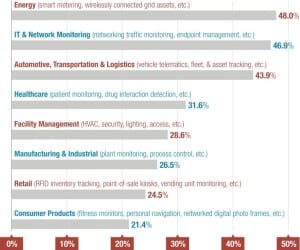 As the graph to the right indicates, organizations have bountiful opportunities before them to boost revenues, cut costs and more effectively serve customers. A few recent examples include:
As the graph to the right indicates, organizations have bountiful opportunities before them to boost revenues, cut costs and more effectively serve customers. A few recent examples include:
Facilities Management – Chicago-based commercial real estate services firm Jones Lang LaSalle (JLL) deployed an M2M system called IntelliCommand to collect data from building systems for security and protection against heating, cooling or fire incidents. Information collected by remote sensors is transmitted to a cloud-hosted system for in-depth analysis. When sensors collect data that strays outside of established parameters, alarms are relayed to a control center to alert managers. JLL’s pilot installation with four sites enabled clients to cut costs by 15-20 percent. The real estate giant is now extending its deployment to 76 buildings.
Consumer –In search of more effective customer servicing, Lexmark uses M2M to collect data from millions of printers. The company analyzes the data to streamline its products to serve customers better, increase revenues and reduce operational costs.
Healthcare – France Telecom R&D launched a project called “Gluconet” for managing diabetic patients remotely, in partnership with the University Teaching Hospitals of Grenoble and Toulouse. A special instrument is used to periodically read patient glycemia data. This information gets transmitted automatically to the management center via mobile devices. The doctors can access the information over the Internet. Based on the analysis, doctors send medical advice to patients via SMS or voice messaging. The key advantage here is that both patients and doctors are alerted of any complications well before they become life-threatening.
Transportation – The US Department of Transportation recently conducted research that suggests that Vehicle to Vehicle (V2V) technology could prevent the majority of crashes involving two or more vehicles. Sensors can monitor speed and location of nearby vehicles, analyze risks and either warn drivers (near term) or take action on their own (longer term) to avoid accidents. The research could lead to a mandate to use V2V in the future.
Retail – A market leader in premium coffee, Nestlé Nespresso SA has equipped its coffee machines used in offices, restaurants, hotels, and luxury retail boutiques to transmit operational and performance data from each machine to a cloud platform for tracking and analysis. The system tracks descaling and other maintenance procedures and alerts technical staff if servicing is required. The applications can also be used to remotely adjust water temperature and pressure.
Applying M2M to Your Organization
Applying the possibilities of M2M are apparent for some organizations. For instance, an equipment manufacturer might see an opportunity to leverage machine data to provide better service and build loyalty. Another might see an opportunity to add value that can be monetized. Some companies might find themselves threatened by competitors who have already started using M2M to gain advantage. But it’s not so cut and dried for some businesses. The “M2M Opportunity Matrix” shown here offers some structure that can be used when thinking about M2M and identifying opportunities that can improve business performance.
 If you look along the top of the Matrix, you will see some of the business objectives you could pursue. This isn’t an exhaustive list, but you could do a lot of good for your business by finding ways to reduce cost, increase revenue or add value.
If you look along the top of the Matrix, you will see some of the business objectives you could pursue. This isn’t an exhaustive list, but you could do a lot of good for your business by finding ways to reduce cost, increase revenue or add value.
Now take a look down the left side for data source options. Your organization might already have a large database of information that’s coming in from POS systems or manufacturing control systems or some other source—Data In-Hand. But maybe you haven’t figured out what to do with the information yet. There might be additional data that you could be collecting from existing “sensors”—New Data from Existing Sources. Or there might be new data that you could access with new sensors, or by sourcing from outside your company—New Data from New Sources. Probably, the data you already have in hand is going to be the easiest to tap to achieve business objectives. But some opportunities might be so valuable that it’s worth deploying new sensors to gather new data.
Where each data source and business objective intersect, a potential M2M opportunity exists. So do some brainstorming. Start by thinking about how to leverage different data sources to achieve various business objectives. It can go in a lot of directions from there.
If it still seems difficult to pinpoint a starting place, one option is to work with a data consultant. He or she can help you to identify low-hanging fruit or the really game-changing opportunities that could deliver more transformative results. There are many right answers. The best course of action is to just get started.
Creating the Future
Well, there are no flying cars or Martian colonies—yet—but other technological advances have proved much more useful. M2M and Big Data Analytics represent a transformational shift in how we work, play and solve humanitarian issues. All of these machines communicating with each other powers intelligent systems that require little to no human intervention and can adapt faster. This frees humans to live more efficient, productive and satisfying lives: spending less time in traffic, getting medical care remotely if needed, living in safer and more energy-efficient buildings and so much more. Just as we could scarcely have predicted the applications for Big Data and M2M that already exist, we can only use our imaginations to predict what lies ahead.
Your organization could have a hand in creating what lies ahead—if you act now. Companies that wait for other people to lead the way tend to get left behind, and that has never been truer than in this era of rapid tehnological change. Examine your data resources and business objectives to find your sweet spot, and hire a data consultant if necessary. You could be part of the driving force that creates the future.
About the Author:
Sam Ganga, Executive Vice President, Commercial Division, DMI.
The commercial division at DMI is tasked with helping customers solve business problems by applying the solution value of emerging technologies. Current practice areas include: Enterprise Mobility, Big Data Insights, Cybersecurity, Cloud Computing, SOA and Java/J2EE. Under Mr. Ganga’s leadership, DMI’s Commercial Division has developed a comprehensive set of Mobile Enterprise Solutions, including mobile strategy, mobile managed services, mobile app solutions and integrated vertical solutions for retail, financial services and healthcare.


